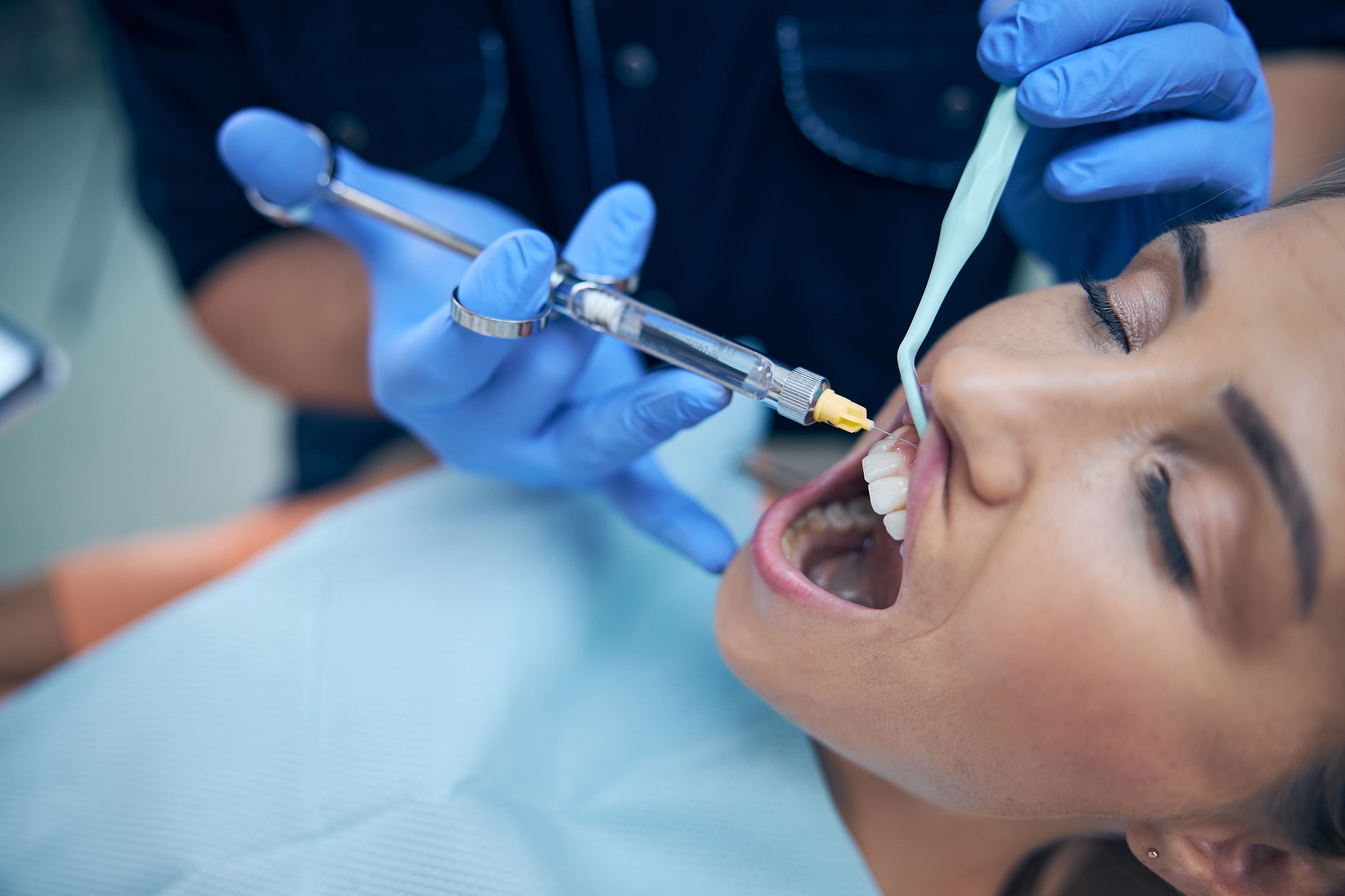In the world of dental care, myths and misunderstandings can often cloud our judgment and…

Everything to Know About Dental Anesthesia for Pain and Anxiety Relief
Many people experience some level of fear or anxiety at the prospect of undergoing a dental procedure. Whether it’s a fear of pain, a needle phobia, or just general discomfort, understanding the nuances of dental anesthesia can ease anxieties associated with oral health care and dental procedures requiring anesthesia. In today’s blog we will demystify these anxieties by providing accurate information on different forms of dental and oral surgery anesthesia. We intend to dispel common misconceptions, creating a more comfortable experience during dental visits.
The Basics of Dental Anesthesia
At its core, dental anesthesia involves using certain drugs to control and mitigate discomfort during dental treatments, from straightforward local injections for to numb a specific area to advanced general anesthesia for inducing feelings of calm or euphoria. The chosen anesthetic depends on several aspects, such as the procedure’s nature and intricacy and the patient’s comfort and overall health status. The most common types are local anesthesia, nitrous oxide, IV sedation, and oral conscious sedation. It’s essential to acknowledge that dental anesthesia aims to transform dental procedures into pain-free and more pleasant experiences for patients.
Local Anesthesia: A Common Choice for All Ages
Local anesthesia, also known as numbing injections, is the preferred choice of anesthesia in for simple dental procedures, ranging from fillings and crowns to more comprehensive procedures like root canals. It is versatile and used in numerous dental procedures for patients of various ages. It involves administering the anesthetic to a specific region in the mouth to numb it, thus reducing discomfort during dental operations.
Local anesthesia’s administration is typically swift and simple, with the numbing effect lasting enough to cover the length of most dental operations. It’s a secure and dependable method that can be tailored to the patient’s requirements, making it popular among dentists for ensuring patient comfort.
Nitrous Oxide
Another common choice for quick, non-invasive dental procedures is nitrous oxide. Also known as “laughing gas,” nitrous oxide is inhaled through a mask and induces a sense of euphoria or light-heartedness, helping to calm any underlying anxiety or nervousness. The effect is almost immediate, helping patients stay relaxed while still being conscious to communicate with the dental team during the procedure.
One of the biggest advantages of nitrous oxide is its fast elimination from the body. Within minutes of stopping the gas and breathing in pure oxygen, you will feel the effects wear off. This speedy recovery time means most patients can safely drive themselves home following their appointment, returning to their daily routine without any lingering sedative effects.
IV Sedation
Intravenous sedation is administered directly into your bloodstream, delivering a deeper level of sedation while still allowing you to stay conscious. IV sedation, provides an exceptional solution for those undergoing intricate dental procedures or for individuals who suffer from high levels of dental anxiety. Many patients recall little to nothing of the dental procedure once the sedation wears off.
However, IV sedation does have a longer recovery period, with the effects persisting for several hours following the procedure. Therefore, you’ll need to arrange for a responsible party to transport you home post-procedure.
IV sedation is a sophisticated method of anesthesia that requires specific expertise. Your dentist communicate with you to get a comprehensive pictures of your health history and current medications before proceeding with this method of sedation.
Oral Conscious Sedation
This dental anesthesia technique involves the use of prescription medication, typically a pill taken prior to your dental procedure. As is the case with IV sedation, the patient is in a calm, relaxed state while remaining responsive to your dentist’s directions throughout the procedure. However, this method is preferred for patients who have a phobia of needles.
Also similar to IV anesthesia, the tranquilizing effect of oral sedation has a longer recovery period compared to other methods. This is usually a matter of a few hours, during which time you might feel slightly drowsy or disoriented, so you will need a ride home after the procedure.
As always, prioritizing your safety and wellbeing is at the heart of dental professionals’ work. So, whether it’s a minor procedure or a more complex one, understanding the different sedation options available can transform your dental care experience, helping you navigate each visit with ease and confidence.
Anesthesia Options for All Ages
Administering dental anesthesia for younger and older patients requires careful thought and planning. In pediatric cases, children may have higher levels of anxiety or unwillingness to cooperate during dental procedures. Your dental team will provide clear, child-friendly explanations about the procedure and offer reassurance to help keep things calm.
With older patients, underlying health conditions can add complexity to the situation. Certain medications or chronic ailments can influence the administration of anesthesia. The dental team will thoroughly assess the overall health status of older patients, incorporating factors such as medical history, current medication regimen, and their general capacity to endure anesthesia.
In both cases, it is crucial to personalize the anesthetic selection to the patient’s specific requirements, targeting the optimal level of safety and comfort. This could involve using less intense forms of sedation, like nitrous oxide, or more profound sedation techniques, such as intravenous dental anesthesia. Regardless, the dental professionals who are responsible for administering the anesthetic must be well-versed in the physiological and psychological variations related to age to provide the most fitting and efficient anesthesia.
Education and Communication Are Key
The importance of patient education is paramount. Dental professionals should explain the procedure, potential side effects, recovery timeline, and any specific aftercare instructions to both the patient and, where relevant, their caregivers before administering anesthesia.
Emphasizing open communication between the patient, their caregivers, and the dental anesthesiologist is of utmost importance. This enables the formation of bespoke anesthesia plans, ensuring optimal safety and comfort levels during all dental procedures.


